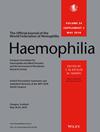Measuring Physical Function Capacity in Persons With Haemophilia: A Systematic Review of Performance-Based Methods
Abstract
Introduction
Currently, physical health assessments in persons with haemophilia focus on bleed-related events and after-effects. The aim of the systematic review was to review and apply standardised criteria to evaluate reliability, responsiveness and construct validity of performance-based instruments evaluating physical capability in persons with haemophilia.
Methods
Medline, CINAHL, Embase, EMCARE, and Cochrane (inception-March 2024) were searched using COSMIN filters for 7 performance-based tests in haemophilia, supplemented by manual searches. Reliability, responsiveness and construct validity of the six-minute walk test (6MWT), timed up and go test (TUG), timed up and down stairs (TUDS), 30-second sit-to-stand (30-STS), single leg stance (SLS), tandem stance (TS) and single hop for distance (SH) were evaluated.
Results
The search yielded 88 abstracts; 25 studies remained after full-text screening, covering 5 of 7 performance-based instruments: 6MWT, TUG, TUDS, SLS, and 30-STS. No performance-based test was evaluated for all properties across all ages. Only TUG in adults and older adults and 6MWT in children and adolescents has been tested for all properties. No test received a high grading. Low and very low grades were given mostly for indeterminate results, small or single studies and lack of a similar construct of comparator. The 6MWT in all age groups was the only performance-based test graded moderate, and this was for responsiveness.
Conclusion
With increasing use of performance-based methods of physical function capacity, evaluating measurement properties is a priority. Until evidence is generated, we can only advocate the 6MWT to monitor responsiveness in adult persons with haemophilia affected with marked arthropathy.
Summary
Understanding Physical Health in People with Haemophilia
Currently, when we check the physical health of people with haemophilia, we mostly look at problems caused by bleeding. But we wanted to see if there are better ways to measure how well people with haemophilia can move and do daily activities.
What We Did
- How far someone can walk in six minutes (6-minute walk test or 6MWT)
- How long it takes to stand up, walk a short distance, and sit down (Timed Up and Go test or TUG)
- How long it takes to go up and down stairs (timed up and down stairs or TUDS)
- How many times someone can stand up from a chair in 30 seconds (30-second sit-to-stand or 30-STS)
- How long someone can stand on one leg (single leg stance or SLS)
- How long someone can stand with one foot directly in front of the other (Tandem Stance or TS)
- How far someone can hop on one leg (single hop for distance or SH)
We wanted to see how reliable (consistent), responsive (can detect changes), and valid (measures what it's supposed to) these tests were for people with haemophilia.
What We Found
We found 25 studies that looked at 5 of the 7 tests (6MWT, TUG, TUDS, SLS, and 30-STS).
- No single test was good for everything and for all ages.
- Only the TUG test (for adults) and the 6MWT (for children) had been fully studied for all aspects (reliability, responsiveness, and validity).
- None of the tests were rated as highly effective overall. Most got low ratings because the results weren't clear, studies were small, or there wasn't enough good information to compare them to.
- The 6MWT was the only test that received a ‘moderate‘ rating, but only for its ability to show changes in all age groups.
What This Means
It's becoming more common to use these kinds of physical tests to understand how well people function. So, it's very important to know if these tests work well for people with haemophilia.
For now, based on the evidence, we can only suggest using the 6-minute walk test (6MWT) to track how much someone's physical ability changes over time, especially for adults with haemophilia who have severe joint problems. We need more research to find better tests.


 求助内容:
求助内容: 应助结果提醒方式:
应助结果提醒方式:


